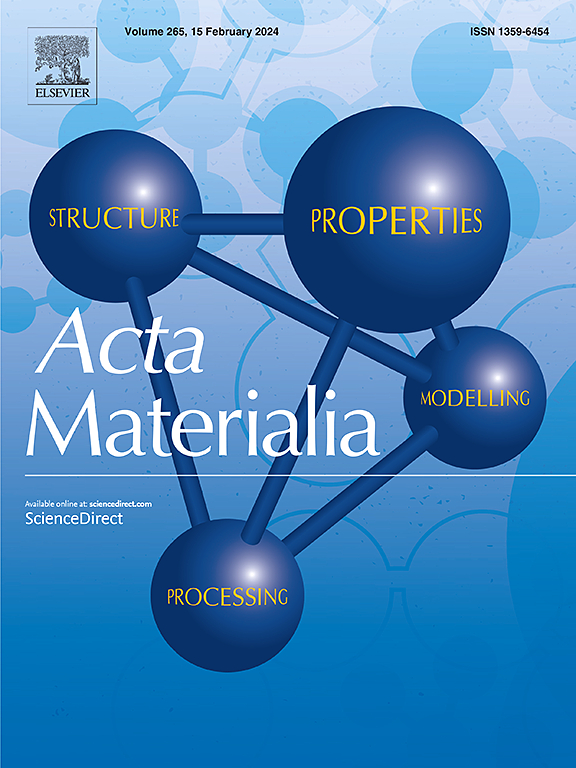在极宽的温度范围内具有优异磁性能的非平衡纳米结构永磁体
IF 8.3
1区 材料科学
Q1 MATERIALS SCIENCE, MULTIDISCIPLINARY
引用次数: 0
摘要
太空探索需要在 2∼450 K 宽温度范围内完全正常工作的轻质高性能永磁体。然而,具有最强室温磁性能的钕铁硼永磁体不适合此类应用,因为它们在高温和低温下的性能都会下降。众所周知,用镨代替钕可增强这些磁体的低温特性,而用钴代替钕可提高高温稳定性。然而,使用传统制造技术,几乎不可能在不显著降低矫顽力的情况下用钴替代超过 10% 的铁。在此,我们提出了一种非平衡纳米结构策略,通过共掺杂镨和钴来实现基体中钴过饱和的非平衡微结构,从而克服温度上限和下限的限制。我们绘制了相图和工作温度图,以确定最佳成分和生产温度,从而生产出具有理想性能的 (Nd0.2Pr0.8)13.6(Fe0.75Co0.25)80.4Ga0.5B5.5 无重型稀土永磁体。工作温度范围从三元钕铁硼磁体的 135-350 K 到 (Nd0.2Pr0.8)13.6(Fe0.75Co0.25)80.4Ga0.5B5.5 磁体的 2-450 K。微结构表征和微磁模拟突出了非平衡微结构在这种磁体中的重要性,而基体中 Co 的过饱和以及不利软磁相的抑制是实现优异磁性能的关键。新型非平衡磁体填补了空间探索用高性能磁体的空白,而非平衡纳米结构策略则为设计具有前所未有特性的磁体提供了新的可能性。本文章由计算机程序翻译,如有差异,请以英文原文为准。


Non-equilibrium nanostructured permanent magnets with excellent magnetic properties over an exceptionally wide temperature range
Space exploration demands lightweight high-performance permanent magnets that are fully functional in a wide temperature range of 2∼450 K. However, Nd-Fe-B permanent magnets, which have the strongest room-temperature magnetic properties, are unsuitable for such applications because of their degraded performance at both elevated and cryogenic temperatures. It is well-established that substituting praseodymium enhances the low-temperature properties of these magnets, while cobalt substitution improves high-temperature stability. However, using conventional manufacturing techniques, it is virtually impossible to replace more than 10 % of iron with cobalt without a significant reduction in coercivity. Herein, we propose a non-equilibirum nanostructuring strategy, which is implemented by co-doping Pr and Co to attain a non-equilibrium microstructure with Co supersaturation in the matrix to overcome both the upper and lower temperature limitations. We constructed phase diagrams and operational temperature maps to determine the optimal composition and production temperature, resulting in a (Nd0.2Pr0.8)13.6(Fe0.75Co0.25)80.4Ga0.5B5.5 heavy-rare-earth-free permanent magnet with the desired properties. The operational temperature range is broadened from 135–350 K for ternary Nd-Fe-B magnets to 2–450 K for the (Nd0.2Pr0.8)13.6(Fe0.75Co0.25)80.4Ga0.5B5.5 magnet. The microstructural characterizations and micromagnetic simulations highlight the significance of non-equilibrium microstructures in this magnet, whereas the supersaturation of Co in the matrix and the suppression of unfavorable soft-magnetic phases are critical to realizing superior magnetic properties. The new non-equilibrium magnet plug the gap of high-performance magnet for space explorations, and the non-equilibrium nanostructuring strategy offers new possibilities for designing magnets with unprecedented properties.
求助全文
通过发布文献求助,成功后即可免费获取论文全文。
去求助
来源期刊

Acta Materialia
工程技术-材料科学:综合
CiteScore
16.10
自引率
8.50%
发文量
801
审稿时长
53 days
期刊介绍:
Acta Materialia serves as a platform for publishing full-length, original papers and commissioned overviews that contribute to a profound understanding of the correlation between the processing, structure, and properties of inorganic materials. The journal seeks papers with high impact potential or those that significantly propel the field forward. The scope includes the atomic and molecular arrangements, chemical and electronic structures, and microstructure of materials, focusing on their mechanical or functional behavior across all length scales, including nanostructures.
 求助内容:
求助内容: 应助结果提醒方式:
应助结果提醒方式:


